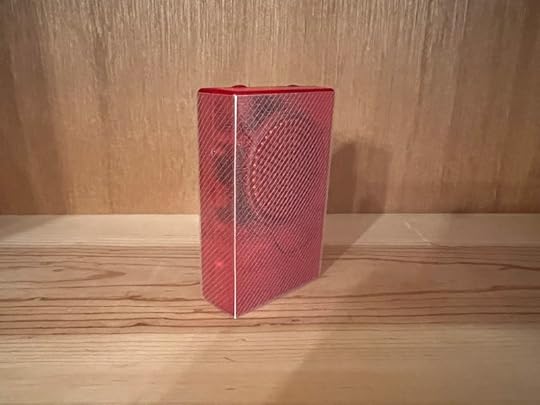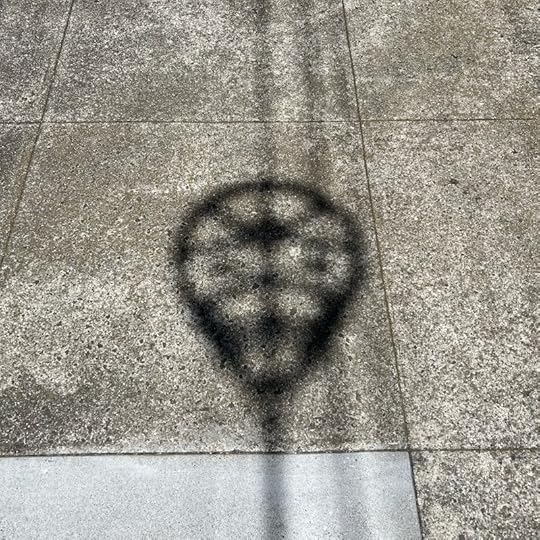Marc Weidenbaum's Blog, page 59
June 7, 2024
This Week in Sound: Loud Food & Cage for Kids
These sound-studies highlights of the week originally appeared in the June 7, 2024, issue of the Disquiet.com weekly email newsletter, This Week in Sound. This Week in Sound is the best way I’ve found to process material I come across. Your support provides resources and encouragement. Most issues are free. A weekly annotated ambient-music mixtape is for paid subscribers. Thanks.
▰ 1. LOUD FOOD
The impact and mitigation of restaurant noise
The Washington Post (gift link) has an excellent, lengthy interactive/multimedia article on the role of sound in restaurants, with an emphasis on the impact and mitigation of noise. Some key takeaways:
“Noise was the most cited complaint in Zagat’s last Dining Trends Survey in 2018.”“the average noise level in restaurants may not be shooting up”“Some acousticians believe we simply became used to quieter surroundingsduring the pandemic, which could make us more aware of loud environments”“Experts are advocating for standards that would not only alleviate customer complaints, but also protect the health of patrons and staff members.”“a vibe that’s either kind of industrial or cool” may explain how modern restaurant design has contributed to the noise issue“Alcohol blunts our hearing,” which may explain “why intoxicated individuals talk louder”“People with autism spectrum disorder have both a higher sensitivity to noise and difficulty in filtering background noise”Hearing difficulty differs from hearing loss: “Age also plays a role in cognitive processing, with older people finding it more difficult to switch attention from one speaker to another”“sound treatment is about 2 to 3 percent of a new venue’s total building costs”The article also covers SoundPrint, an app (iOS, Android) I’ve mentioned previously: “The app’s developer, Greg Scott, has been looking at data collected from about 14,000 active monthly users from more than 6,000 restaurants during the past four years, and he’s optimistic venues are not getting louder. According to Scott’s data, the average decibel readings in restaurants have been below 77 … for the past two years.” (Thanks, Mike Rhode!)
▰ 2. TALK (SORT OF) LIKE THE ANIMLAS
A classroom exercise on human/chimpanzee distinctions
The Journal of the Acoustical Society of America has a piece (its title is, in part, “What’s special about human speech?”) introducing differences between humans and chimpanzees, in the process exploring why it may be that humans have speech and chimpanzees do not: “For example, modern humans are unique among primates in having lost the vocal membranes of the larynx during human evolution.” The numerous graphics in the article show differentiations between how people speak alongside data on a “home-raised” and “speech-trained” chimpanzee, named Viki. This example shows the relative clarity of a human speaking the word “cup”:
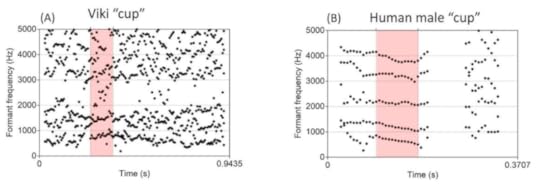
The article is by William P. Shofner, Associate Professor of Speech, Language and Hearing Sciences at Indiana University Bloomington. Shofner details an exercise from a course he has taught since 2021 that “provides students with important insights into the anatomical differences between humans and chimpanzees related to vocal production.” It covers aspects of chimpanzee vocalization focused on the mouth and larynx, and also notes genetic matters and neural circuitry. While scientific, certainly, it’s not difficult to follow.
▰ 3. CAGE FOR KIDS
A splendid new children’s book
Nothing: John Cage and 4’33” is the title of a new book for kids about the composer John Cage and his most famous work. It was written by Nicholas Day and illustrated by Chris Raschka and came out in April from Neal Porter Books. Said Day in an interview with Publishers Weekly: “I think Cage is kind of the most open — especially late Cage — and, to use the word joyful, open-spirited of a composer. And that’s part of why 4’33” works so well as a question for children to start with, right? Because it’s this thing that can feel alienating to people who have had more contact with the world, but if your experience with the world is still fresh, the questions that 4’33” asks seem intuitive and perfectly natural.”

Reactions to the book have been overall positive. “Twice, the word nothing is scrawled in cursive on a double-page spread featuring just that word, giving readers space to pause and absorb the concept,” notes Julie Hakim Azzam in a review (Azzam is assistant director of the MFA program in the School of Art at Carnegie Mellon University). And in the School Library Journal, Kirsten Caldwell wrote: “Children will be encouraged to discover what music means to different people and to explore the silence. The watercolor illustrations bring this story to life in their whimsicality, but they do not trivialize the event or aftermath.”
And of course, that isn’t John Cage on the book’s cover. That would be David Tudor, who premiered 4’33” on August 29, 1952. (Thanks, Mike Rhode!)
▰ 4. AN AI ROUNDUP
It might as well stand for “audio intelligence”
Once upon a time, concern about nanotechnology focused on the concept of gray goo, a “a hypothetical global catastrophic scenario” in which the Earth would be covered by rapidly reproducing machines. With artificial intelligence, a parallel concern might be the sheer onslaught of news. These are just a few of the many recent sound/voice/audio-related items:
Nature reports on the proposed use of large AI datasets to diagnose depression. One can only imagine the privacy impact, were this used during, say, job interviews or on dating services.Stable Audio Open is an open source text-to-audio model for generating up to 47 seconds of samples and sound effects.The US Justice Department declined to make public recordings of the president’s recent testimony, stating that “releasing the audio could ignite an artificial-intelligence-powered deepfake frenzy.”Actors Paul Skye Lehrman and Linnea Sage are suing an AI company (New York Times gift link) they say reportedly cloned their voices without their permission. (Thanks, Rich Pettus!)A political consultant in the US who used deepfakes in robocalls faces a $6 million fine and political chargesAI is now able to be used to separate distinct Indian classical instruments, for use in film and music productionFliki is a “Text to Video editor featuring lifelike voiceovers” Underlord is “a toolbox full of AI gadgets that make obvious edits and fix lousy audio.”ElevenLabs (which was in the news earlier this year as the tool used for making political deepfakes) has a service that lets you “Generate any sound imaginable from a text prompt”June 6, 2024
Disquiet Junto Project 0649: Concerto for [ ]

Each Thursday in the Disquiet Junto music community, a new compositional challenge is set before the group’s members, who then have five days to record and upload a track in response to the project instructions.
Membership in the Junto is open: just join and participate. (A SoundCloud account is helpful but not required.) There’s no pressure to do every project. The Junto is weekly so that you know it’s there, every Thursday through Monday, when your time and interest align.
Tracks are added to the SoundCloud playlist for the duration of the project. Additional (non-SoundCloud) tracks also generally appear in the lllllll.co discussion thread.
These following instructions went to the group email list (via juntoletter.disquiet.com).
Disquiet Junto Project 0649: Concerto for [ ]
The Assignment: Write a piece of music informed by the concerto form
Step 1: Familiarize yourself with the concerto form. For example, consider the idea of having a soloist amid a larger instrumental setting, and of having a three-part structure that goes fast, then slow, then fast again.
Step 2: Needless to say, you needn’t necessarily record a piece of classical music, but employ what you know about concerto form in a new, original piece of music.
Tasks Upon Completion:
Label: Include “disquiet0649” (no spaces/quotes) in the name of your track.
Upload: Post your track to a public account (SoundCloud preferred but by no means required). It’s best to focus on one track, but if you post more than one, clarify which is the “main” rendition.
Share: Post your track and a description/explanation at https://llllllll.co/t/disquiet-junto-project-0649-concerto-for/
Discuss: Listen to and comment on the other tracks.
Additional Details:
Length: The length is up to you. It’s need not be symphonic.
Deadline: Monday, June 10, 2024, 11:59pm (that is: just before midnight) wherever you are.
About: https://disquiet.com/junto/
Newsletter: https://juntoletter.disquiet.com/
License: It’s preferred (but not required) to set your track as downloadable and allowing for attributed remixing (i.e., an attribution Creative Commons license).
Please Include When Posting Your Track:
More on the 649th weekly Disquiet Junto project, Concerto for [ ] — The Assignment: Write a piece of music informed by the concerto form — at https://disquiet.com/0649/
June 5, 2024
Guitar Process
Been working on my guitar practice. I remain a terrible guitarist, but I enjoy the learning process and have been trying to use my practice time more effectively. I take lessons weekly. Current areas of focus:
Working on 7th chords, and some 9th chord forms, as wellWorking on a mix of holding the pick with two fingers and using the remaining three fingers for individual string picking and arpeggiosWorking on better recognizing which notes in a given chord form are the root, third, and fifthStill trying to memorize the fretboard (in EADGBE), which continues to elude meStill working on one song at a time over an extended period of timeVoice leading remains a big priority for meStill working on using my guitar through a synthesizer, but not mistaking the time with the synth as guitar practice, per seOrdered a nifty device that will, apparently, let me isolate each of the six strings for individual processing and/or recording, something I’ve previously attempted to approximate with equalizers and filter banksNow I need an audio interface with sufficient inputs to take advantage of the above nifty device, likely something like thisJune 4, 2024
Office Signal Flow
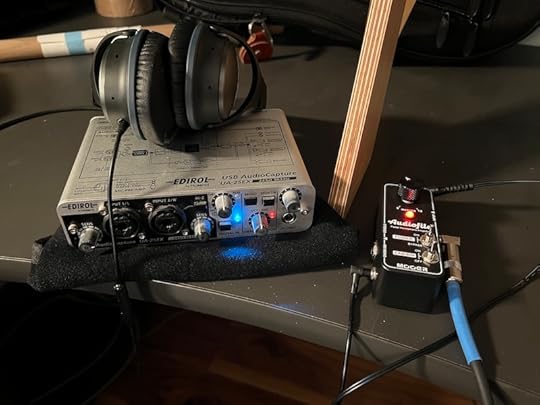
Office guitar setup: the one on the right goes right into my ears, while the one on the left goes into my iPad or laptop and then into my ears.
New Susie Ibarra Book
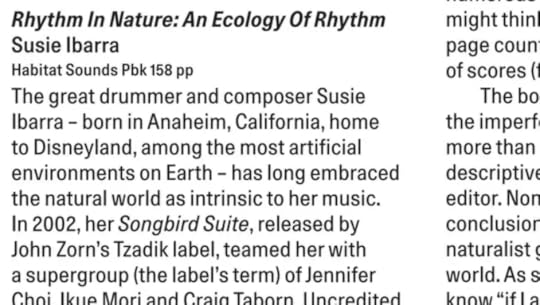
My review of percussionist Susie Ibarra’s new book, Rhythm in Nature: An Ecology of Rhythm (Habitat Sounds, 158 pages), is in the current issue of The Wire, the one with Tomeka Reid on its cover. Here’s the first paragraph:
The great drummer and composer Susie Ibarra — born in Anaheim, California, home to Disneyland, among the most artificial environments on Earth — has long embraced the natural world as intrinsic to her music. In 2002, her Songbird Suite, released by John Zorn’s Tzadik label, teamed her with a supergroup (the label’s term) of Jennifer Choi, Ikue Mori and Craig Taborn. Uncredited were additional participants: the birds whose music could be heard on the title track, not merely sampled, but having provided evident inspiration for her antic percussion and for Taborn’s impressionistic piano playing. Two decades on, Ibarra’s Walking on Water (Innova, 2021) melded a larger ensemble with more birds and, trenchantly, the sounds of glaciers in decline. At times during Walking on Water, a listener might think Ibarra’s music had lost a battle with the field recordings, before coming to recognise the water is, in fact, the music.
June 3, 2024
June 2, 2024
June 1, 2024
Scratch Pad: Chimes, RSS, Books
I do this manually at the end of each week: collating (and sometimes lightly editing) most of the recent little comments I’ve made on social media, which I think of as my public scratch pad. Some end up on Disquiet.com earlier, sometimes in expanded form. These days I mostly hang out on Mastodon (at post.lurk.org/@disquiet), and I’m also trying out a few others. I take weekends and evenings off social media.
▰ Multiple devices in the house ring out, slightly out of sync, all pinged semi-but-not-quite-simultaneously by an ongoing sequence of text messages — the same alerts on multiple accounts associated with multiple gadgets. It’s a wind chime for which the breeze is conversation.
▰ Me in guitar class: I’m pretty solid on the chords and the voicings until the start of the [whatever section of the sheet music] and then I look ahead and it’s like reality splinters entirely
▰ A blog without an RSS feed is like a … ?
▰ I took me a few months, a year or so ago, to train myself to write in ALL CAPS (for clarity). It has taken less time to train myself to hold the guitar pick with two fingers instead of three (for utility of my pinky, ring, and middle — an arpeggio’s version of clarity), but I’m not quite there yet.
▰ When I first started doing interviews as a music critic, I found the best examples of how to express conversation with just text involved simply studying how playwrights did it. I mostly read David Mamet and Dennis Potter at the time.
▰ I’ve had odd browser issues. This one is new. I turned on my MacBook. Safari had lots of tabs open in two different windows. I thought I’d gone overboard with tabs yesterday, then realized the windows were duplicates. I shut a set down, shut Safari down, reloaded — and now all the tabs are gone. :(
▰ I had to look up “rip-rap.”

▰ I finished reading three books this week: a novel and two graphic novels. The novel (my 14th this year) was Beyond the Hallowed Sky by Ken MacLeod (after Warren Ellis recently noted the third in the series of which this is the first). I enjoyed it a lot and will be moving on pretty soon to its sequel, though right now I’m deep into Virginia Woolf’s Mrs. Dalloway, which I haven’t read since college (and I’m not sure I paid a lot of attention to it then). The graphic novels were: The Gull Yettin by Joe Kessler, who as always manages to be abstract and sentimental, messy and elegant, at the same time (also, it reminds me of Frank Santoro’s work, which I mean as a compliment), and Nejishiki, one of five volumes (thus far?) of Yoshiharu Tsuge’s manga published by Drawn & Quarterly. I’d only previously read The Swamp, from which this is a long, dark stretch away.
May 31, 2024
Ken MacLeod’s Ear

Yes, I’m enjoying Beyond the Hallowed Sky by Ken MacLeod. It’s the first book in his Lightspeed trilogy. And l love this reminder that included among the sounds of nature are the trademark sounds of the people who tell us about nature.
May 30, 2024
15 Minutes
Happiness is when one of your favorite neighborhood dumpling shops (we have more than our fair share) also sells them frozen



